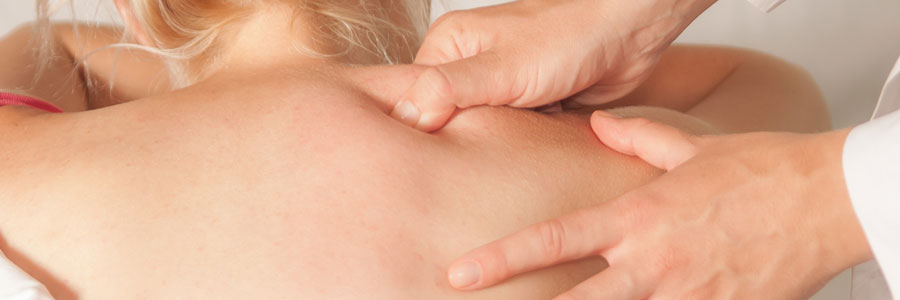OMT
Some examples of Osteopathic Manipulative Treatments (OMT)

IMPORTANT CONCEPT:
Range of Motion: movement of a body part to its physiologic or anatomic limit in any or all planes of motion
Goal of OMT: Is to maximize the physiologic barrier toward the anatomic barrier.
Osteopathic Techniques
Muscle Energy Counterstrain Myofascial Release Lymphatic Articulatory Cranio-Sacral HVLA (high velocity low amplitude) Muscle Energy: Manipulative treatment in which the patient’s muscles are actively used on request from a precisely controlled position, in a specific direction, and against a distinctly executed counterforce.
Example of Technique: The patient actively co-operates with the physician to contract a muscle or muscles, inhale or exhale, or move one bone of a joint in a specific direction relative to the adjacent bone.
Reason for Applying: Applied to strengthen weak muscles, activate inhibited muscles, and strengthen short, tight muscles.
Effect of Treatment: Mobilizes joints in which movement is restricted, stretches tight muscles and fascia, or fibrous tissue, that envelops the body beneath the skin, encloses muscles and groups of muscles, improves local circulation, and balances neuromuscular relationships to alter muscle tone and improve joint movement.
A DIRECT TECHNIQUE
Counterstrain: Technique in which patient is placed in position of comfort, maintains the position for a period of time, then is assisted by the physician to slowly return to a neutral position.
Example of Technique: Patient is placed in position of comfort for 90 seconds, and then is slowly returned to a relaxed and neutral position.
Reason for Applying Applied to relieve the physical pain of patients suffering from “tender points”, to relieve referred pain from active trigger points and to normalize imbalances in the autonomic nervous system.
Effect of Treatment: Identifies tender points and positions the patient to eliminate the tenderness.
AN INDIRECT TECHNIQUE
Myofascial Release: Also referred to as MFR, this procedure is designed to stretch and reflexly release patterned soft tissue and joint-related restrictions.
Example of Technique: Physician twists, shears, and compresses joints while simultaneously feeling tissue and joints for shifting tightness and looseness.
Reason for Applying: Applied to patients suffering from muscle tightness. Effect of Treatment: Joint-related movements are assessed and treated simultaneously. Joint and muscle movements are improved and pain is decreased.
DIRECT OR INDIRECT TECHNIQUE
Lymphatic Technique: This manual procedure is designed to promote circulation of the lymphatic fluids
Example of Technique: Pressure is applied with the physician’s hands to the supine (face up) patient’s upper anterior (front) chest wall. When the force applied to the chest reaches its maximum on expiration, the physician’s hands are removed suddenly. This increases negative pressure of the chest to assist the body’s respiratory mechanism to move lymphatic fluids.
Reason for Applying: Can be used to relieve upper and lower respiratory infections. Effect of Treatment: To mobilize lymphatic drainage and facilitate recovery from infection.
DIRECT OR INDIRECT TECHNIQUE
Articulation: Physician gently and repeatedly forces the joint against the restrictive barrier, intending to reduce the barrier and improve motion.
Example of Technique: Physician moves the affected joint to the limit of all ranges of motion. As the restrictive barrier is reached, slowly, and firmly the physician continues to apply gentle force against the joint to the limit of tissue motion, or the patient’s tolerance to pain or fatigue. The articulation is slowly repeated several times: each time gaining increased range and improved quality of motion.
Reason for Applying: Most often applied to postoperative patients and elderly patients suffering from arthritis. Effect of Treatment: Enhances the effect of passive articulating motion by resisting it or permitting increased range of motion.
DIRECT OR INDIRECT TECHNIQUE
Cranio-Sacral: Cranial Osteopathy is a systematic approach to patient diagnosis and treatment utilizing the body’s inherent fluctuation of cerebrospinal fluid. This is called Cranial Rhythmic Impulse (CRI) or Primary Respiratory Mechanism (PRM). This gentle, manual technique uses the CRI to treat the whole person, emphasizing the head and spinal regions.
Example of Technique: Physician compresses and palpates for motility of the CSF and mobility of the intracranial and intraspinal membranes. The cranial rhythmic impulse is palpated and a balancing force is applied.
Reason for Applying: Applied to patients with headaches or cranio-sacral compression Effect of treatment: Mobilization of cranial bones and cranial rhythmic impulse movement. To relieve headache-like symptoms.
DIRECT OR INDIRECT TECHNIQUE
HVLA: (HIGH VELOCITY LOW AMPLITUDE) Moving a restricted joint in the direction it is resisting.
Example of Technique: Physician slowly pulls joint in the direction it is resisting. Once at the point of muscle resistance, the physician continues to slowly pull against the muscle restraint, while applying a quick force localized to the area of resistance often resulting in a “pop” in the affected joint.
Reason for Applying: Treats motion loss and impaired or altered functions of the body’s framework.
Effect of Treatment: Immediate increase in range and freedom of motion.
A DIRECT TECHNIQUE CONTRAINDICATIONS:
OSTEOPOROSIS ,BONY METASTASIS, LOCAL / ADJACENT FRACTURE
References: Dr.Simmons.net Stephen Barrett, MD aoa-net.org “Osteopathic manipulation may effectively treat back pain,” WebMD 11/3/99. “A Comparison of Osteopathic Spinal Manipulation with Standard Care for Patients with Low Back Pain,” NEJM, 11/4/99. “Osteopathy,” WholehealthMD.com,

